With the right search engine optimization (SEO) strategy, financial advisors and planners can increase organic visibility for their websites and business services on search engines like Google, Yahoo, and Bing to attract more clients.
This guide explains the fundamentals of a good SEO strategy for financial advisors and planners that can be implemented from start to finish to generate a new stream of organic leads.
SEO for Financial Advisors & Planners Strategy Guide
1. Set Up an Optimized Google Business Profile
The first step for doing SEO for financial advisors and planners is to set up an optimized Google Business Profile. Creating a Google Business Profile is critical for financial managers who have a physical location and want to attract local clients.
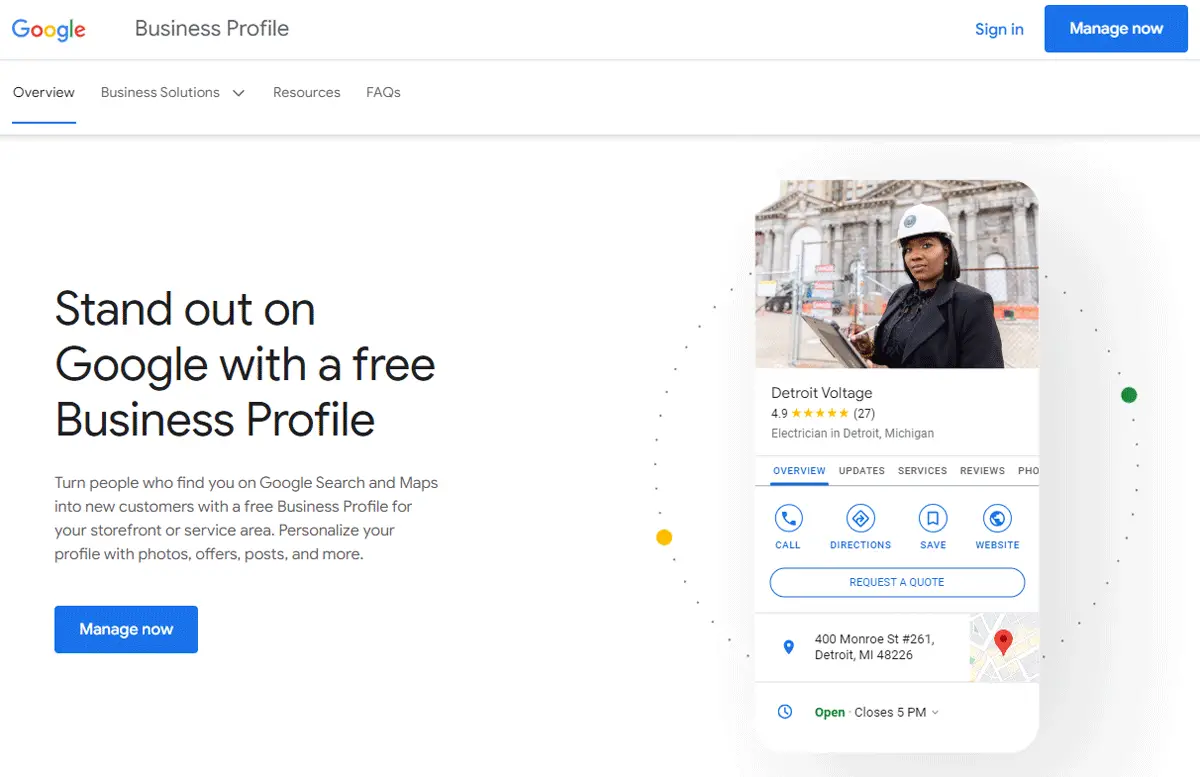
Having a Google Business Profile with a verified address will help your financial advising and planning services get discovered for both local search results. Without a Google Business Profile, your website will not appear for local search queries or be displayed in Google Maps for potential clients to find your business when looking for wealth management services.
Additionally, the better optimized your Google Business Profile is for SEO, the better it will rank for (relevant) local searches. For example, Google Search contains a feature called the “Map Pack” which consists of three businesses its systems determine are the most relevant for the user. And which financial advisor or planner has the best optimized listing, typically wins one of those top three spots.

Follow these best practices to optimize your Google Business Profile for local SEO:
- Set Up a Google Business Profile: Go to google.com/business/.
- Complete All Information Fields: Fill out as much information as possible for your business listing, including the physical address, phone number, and category. The more information you include, the easier it is for Google to match your business with relevant keyword searches.
- Put Relevant Keywords In the Business Description: Adding relevant keywords for your financial advising and planning services in the business description can help Google match your listing to more local searches.
- Include Your Business Hours: List your hours of operation for each day of the week. Also, update your listing to include holiday hours as the approach. This improves the reliability of your Google Business Profile which can help improve visibility during certain times of the year.
- Add Photos: Photos are an essential element for financial advisor SEO on Google Business. Uploading photos to your Profile helps show off your building so potential clients will want to visit your location and know that they’re in the right place upon arrival. You can also add images that demonstrate your expertise in wealth management such as awards, certifications, client meetings, etc.
- Verify Your Location: Verification is essential for proving your business is located where you say it is. A verified location on Google Business increases your chances of showing up on Google Search and Google Maps.
- Create Optimized Google Posts: Google lets you create posts that appear on your Google Business Profile for new offers, company updates, and events. Each time you create a new post, make sure to add relevant keywords to the content. That way, you can keep your Google Business Profile optimized for the phrases and terms that matter most for attracting the right financial advising and planning clients.
Following these tips will improve the basic optimization of your Google Business Profile. For more advanced SEO tips, check out our Google Business Optimization Checklist and this dedicated guide on How to Add Keywords to a Google Business Profile.
2. Get Google Reviews for Your Financial Services
The next step for implementing SEO for financial planners and advisors is to get more reviews on your Google Business Profile. Google specifically states that reviews build trust and help your Business Profile stand out to customers on Google Search and Maps.
According to a local ranking case study by Semrush, and SEO tool provider, “For listings on Google Maps, our local rank trackers found that the average number of reviews for a listing had a significantly stronger impact on its performance, compared to average rating. In fact, we found that average rating did not correlate with placement for the first three positions.”
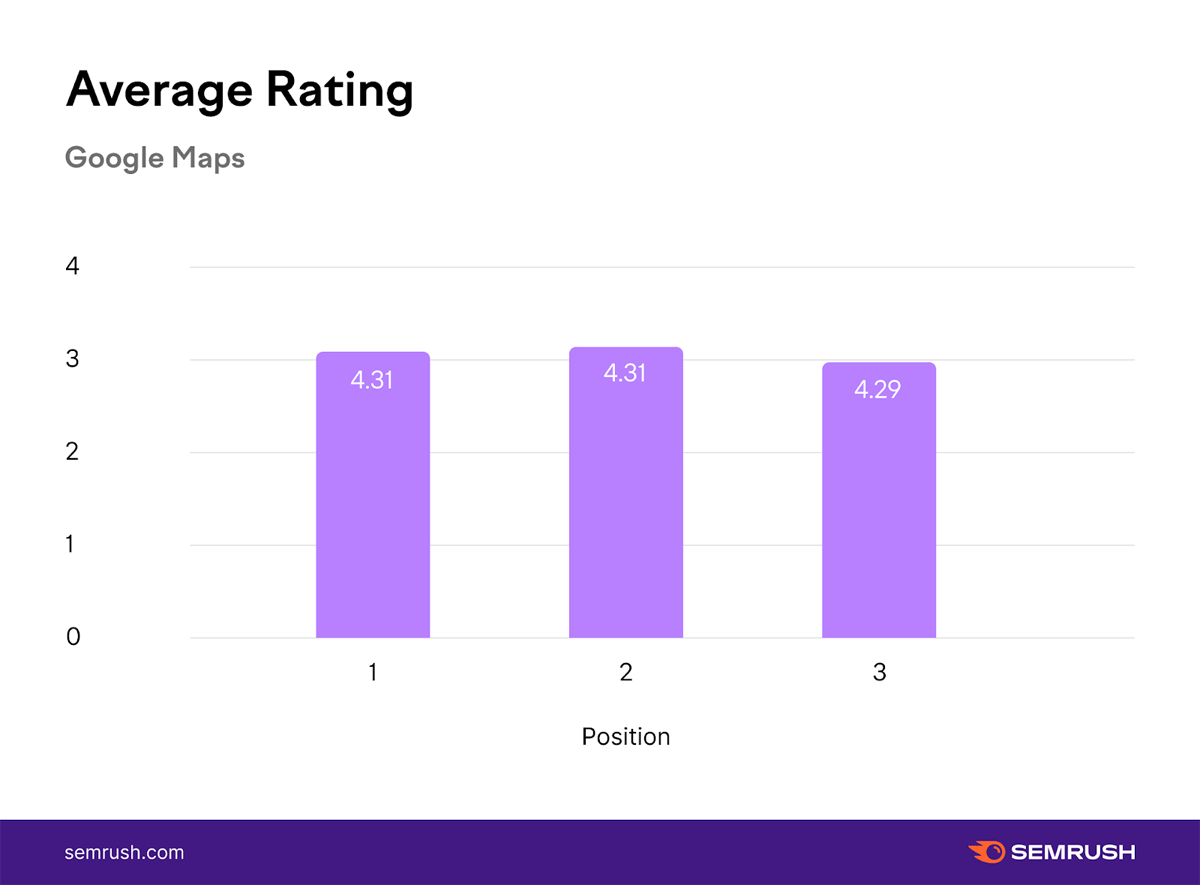
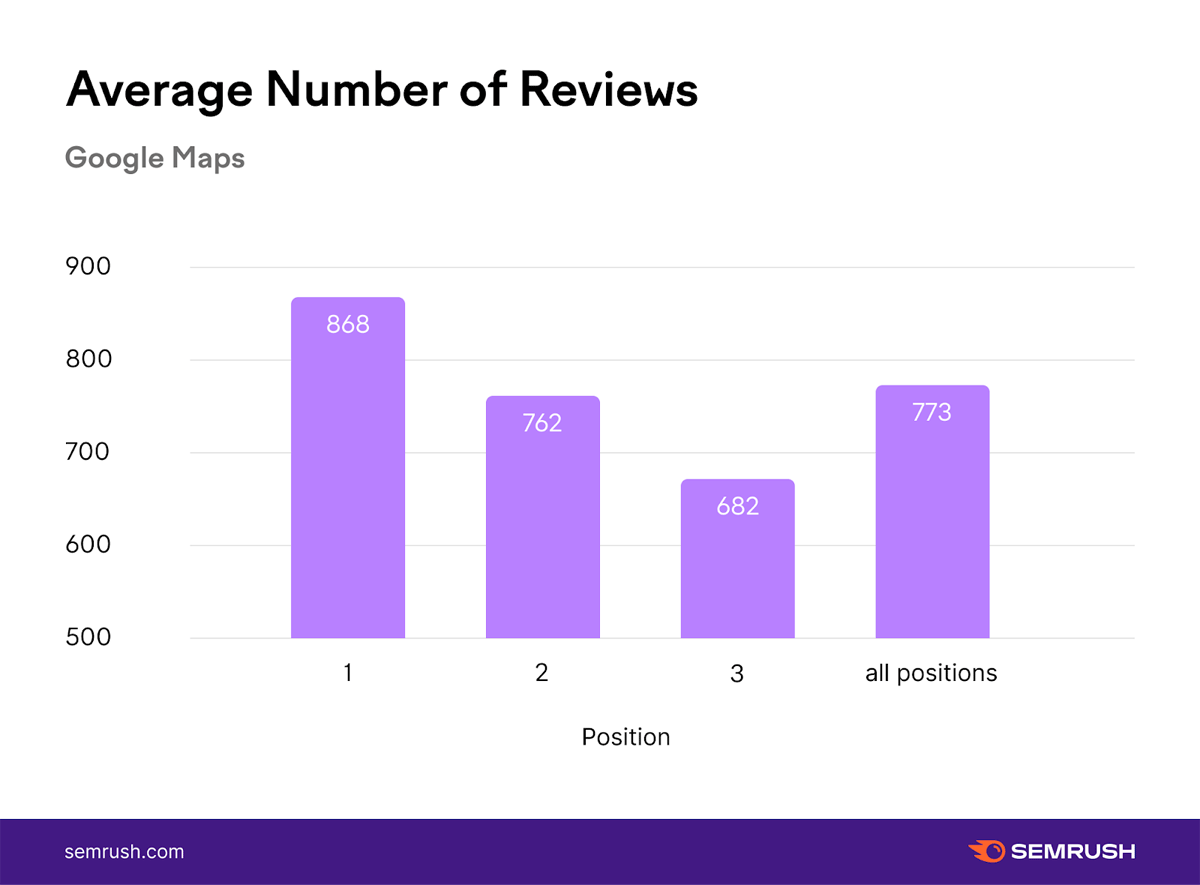
A BrightLocal local consumer review survey discovered that “the average consumer reads 10 reviews before feeling able to trust a business.” Therefore, local businesses like financial advisors and planners should make sure the top 10 visible reviews on Google Business (and other online review sites) are indicative of the business experience they want to portray to maximize the chances of impressing potential leads.
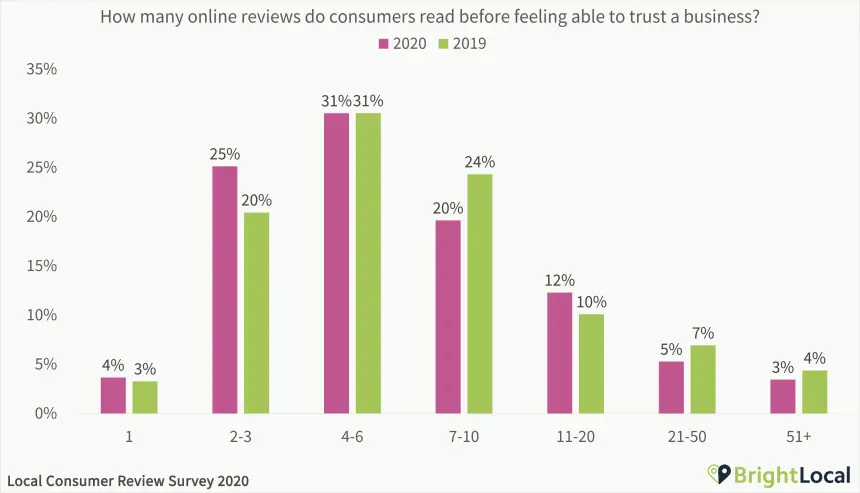
These results show how important it is to encourage as many satisfied clients to review your financial advising or planning business as possible. Together with a well-optimized Google Business Profile, achieving a high volume of reviews and an average rating of 4 or higher can help to improve visibility in Google Maps results.
One of the simplest ways to use this SEO strategy for financial planning and advising is to share your Google reviews link with current clients and ask them to leave a review of your services. You can send the link via email, in a text message, and put it on printed materials such as invoices or receipts. You can also share the review link directly on Facebook from your Google Business Profile.
Follow these steps to get your Google review link:
- Go to your Google Business Profile.
- Click the “Ask for Reviews” button.
- Click the review link to copy it.
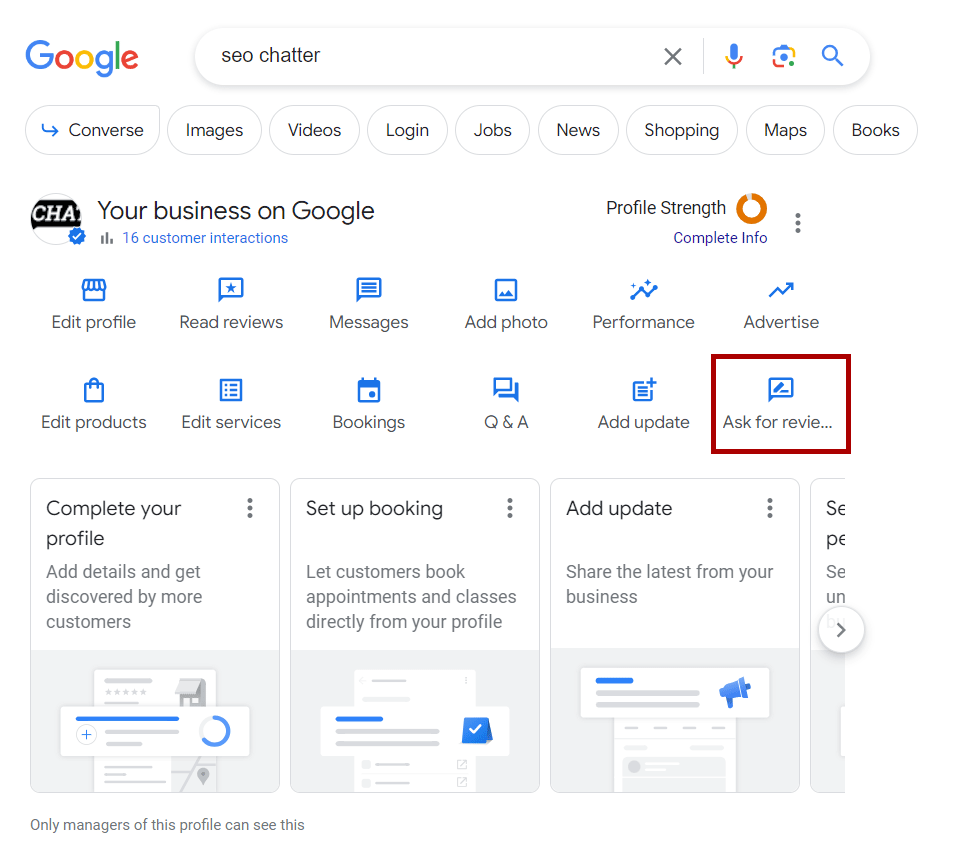
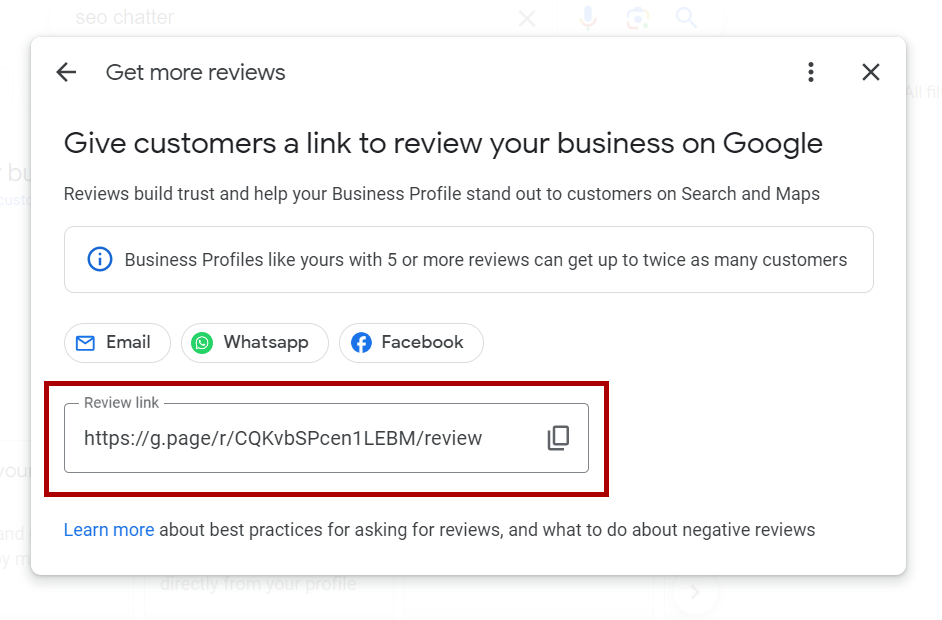
Another important tip here is to respond to all Google reviews your business receives. If a person leaves a review, make sure to immediately respond to it; regardless if it’s a good or bad review. This demonstrates to your potential clients that you are active on the Google Business platform and care about your clients’ experiences. Some SEO experts also believe that this interaction with reviewers helps boost visibility for the listing in local search results.
3. Add NAP & Schema Markup to Your Website
NAP refers to the name, address, and phone number of a business. Having consistency online for your NAP information is an important step in building a good SEO strategy for financial advisors and planners because it impacts local Google search rankings.
A mismatch of NAP information online can cause a number of ranking issues for a business and its website, which you don’t want to happen. Therefore, you want to make sure that you stick with a specific structure for your business’s name, address, and phone number across all websites your business is listed on, including your own.
For example, there are many ways to format an address for a business that’s located on a route highway, such as:
- Route 20
- RTE-20
- RT-20
- US Route 20
- U.S. Route 20
- Highway 20
- US Highway 20
- U.S. Highway 20
The best tip for financial planner SEO is to establish a single standard format for the address and stick with it throughout every marketing channel. This will reduce confusion for the search engine ranking algorithms about the NAP information. The same thing is true for the business name and phone number format. Always keep every part of these elements exactly the same when posted on the Internet.
After you’ve established consistent NAP information for your financial advising business, you’ll then want to make sure the NAP information is listed accurately on all of the site’s web pages. This helps verify the listings that Google’s algorithm crawls on third-party sites are accurate.
There are three ways to implement this SEO strategy for financial advisors and planners:
- Put the name, address, and phone number in the visible footer section of the website.
- Include the NAP information on both the About and Contact pages for users to easily find.
- Include Schema Markup with the NAP information in HTML code that is not visible to users.
The visible NAP information on your site is important for visitors, but the hidden Schema Markup is used by Google’s crawler to attribute the accurate NAP details for your business.
Schema Markup requires a bit of technical SEO knowledge to implement; however, it’s important to ensure that the correct name, address, and phone number are attached to your financial services business without any mistakes. Schema Markup also helps improve the quality of your business listing on other search engines like Bing and Yahoo because it will have key information to display for your site in the search results.
The easiest way to create Schema Markup for SEO is to use one of these Free Schema Markup Generators. No special skill is required to get the correct structured data you need to place in the HTML code of your website.
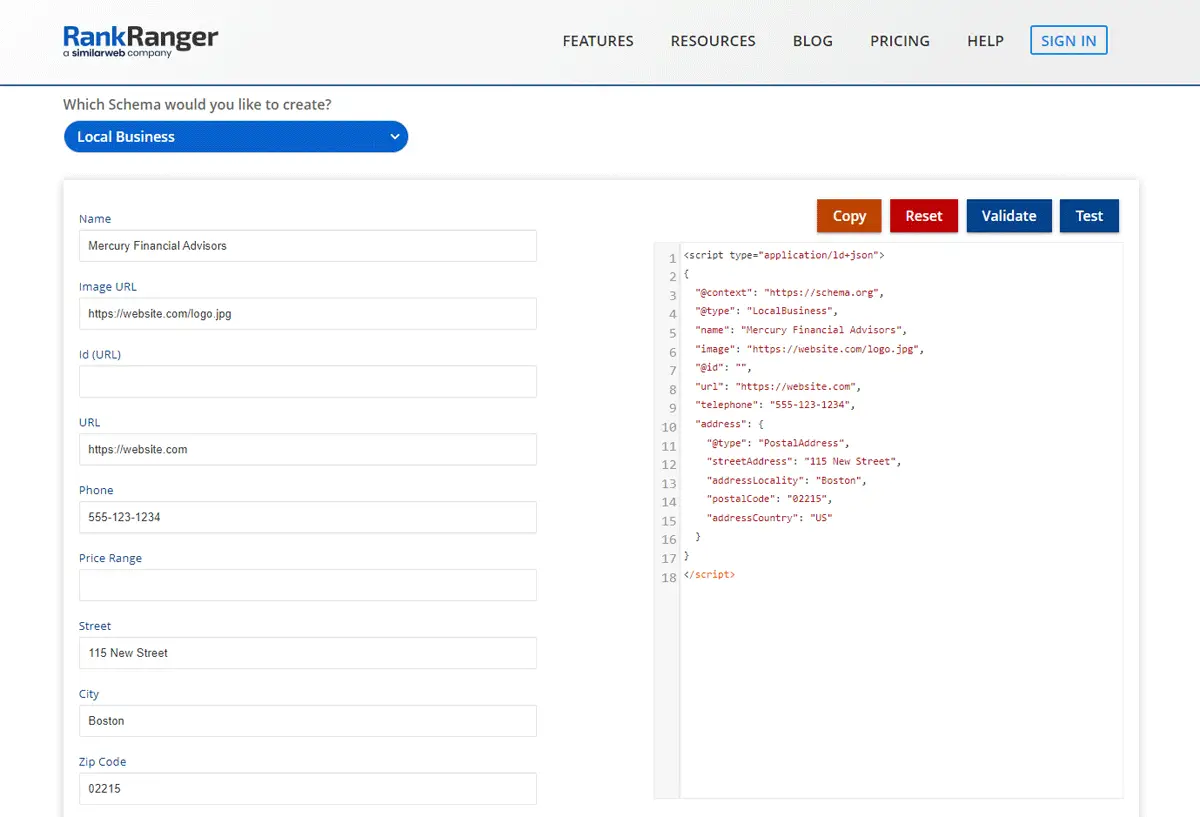
Taking Rank Ranger’s Schema Markup Generator for example, you can choose the “Local Business” option to get the correct fields for NAP and local SEO. Once you’re done using the tool, copy the HTML code and place it in the HTML footer section of your financial planning site. If you are using the WordPress content management system, you can install a free plugin like WPCode to gain access to the header and footer code blocks to copy and paste the generated Schema Markup into the HTML.
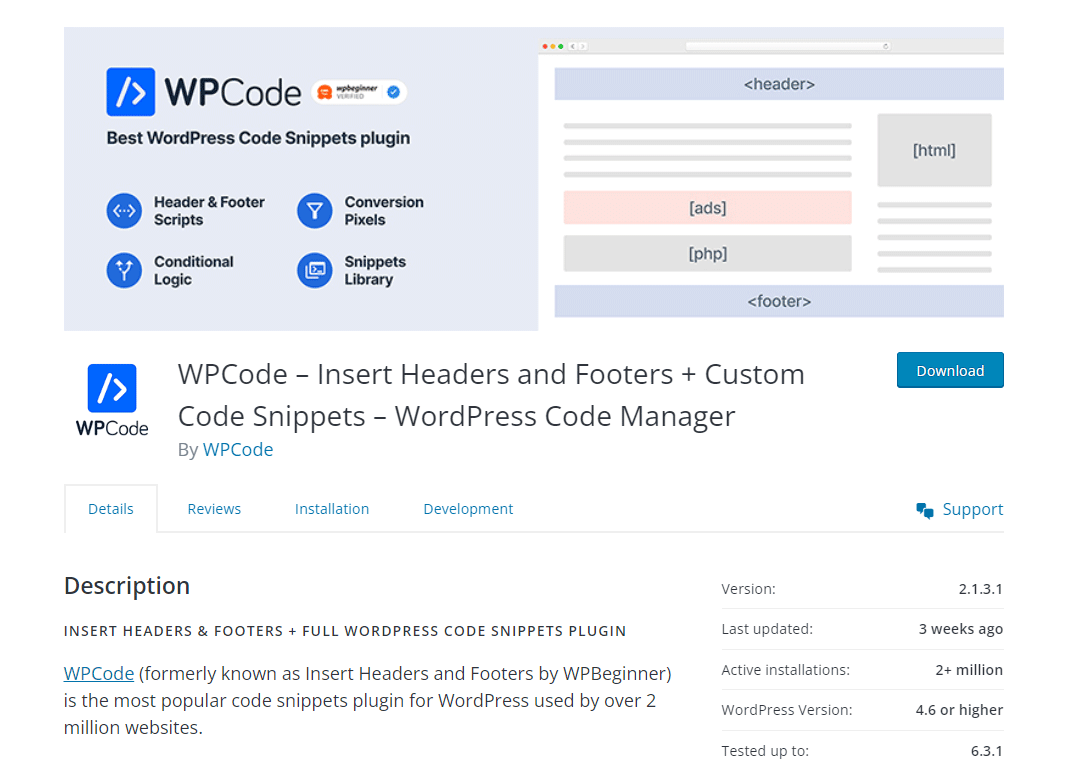
Once you’re done with this step, the foundation of your financial services website will be set up correctly to rank for local searches in Google, Yahoo, and Bing. To further maximize your results, you’ll want to optimize the on-page SEO elements as mentioned in the next few steps of this guide.
4. Create Local Citations
Local citations are a type of SEO crosslinking that is made up of directory listings with online profiles that include your business’s NAP information and website URL. These types of online citations are an important part of your SEO strategy because help to verify the NAP information you listed on your website is true and can act as authoritative backlinks to boost off-site SEO signals that can help with local search rankings.
Additionally, some local business directory sites rank high in Google for relevant keyword searches. For example, Yelp is a site that often ranks in the top 10 positions on Google for local search queries, especially when users add “near me” to the end of the search phrase (e.g. financial advisors near me).
If your financial advising and planning business is listed on these types of sites, you can take advantage of the SEO strategies those sites have put into place to rank high on the search engines and acquire free organic referral traffic.
Below is a general list of sites you can use to build free and paid local citations for your financial services business. The more local citations you create, the better search engine visibility your business will have on Google, Yahoo, and Bing.
- yelp.com
- foursquare.com
- bbb.org
- local.yahoo.com
- mapquest.com
- yellowpages.com
- angi.com
- here.com
- city-data.com
- manta.com
- tomtom.com
- justlanded.com
- citysearch.com
- merchantcircle.com
- superpages.com
- dandb.com
- us.kompass.com
- factual.com
- local.com
- brownbook.net
- company.com
- yellowbook.com
- chamberofcommerce.com
- infobel.com
- insiderpages.com
- yellowbot.com
- communitywalk.com
- elocal.com
- hotfrog.com
- ezlocal.com
- local.botw.org
- storeboard.com
- tupalo.com
- cybo.com
- ibegin.com
- salespider.com
- showmelocal.com
- neustarlocaleze.biz
- citysquares.com
- n49.com
- cylex.us.com
- yasabe.com
- threebestrated.com
- 2findlocal.com
- bizvotes.com
- b2byellowpages.com
A full list of business directories for building local citations for SEO can be found here: Free Business Listing Sites.
5. Identify Relevant Keywords for Financial Advising & Planning
The next step in doing SEO for financial advisors and planners is to work on optimizing the website for relevant keywords. This process is done in two ways:
- Identifying SEO keywords for the homepage and financial services pages.
- Identifying long-tail keywords for blog posts on financial topics.
Choosing Keywords for the Homepage and Financial Services Pages
To get started, think about the types of words and phrases potential clients would use to find your financial services online. This SEO strategy will serve as the foundation for your homepage and pages that list individual financial services.
For example, If you’re trying to attract local clients who need a financial advisor, financial planner, or wealth manager, then you’ll want to focus on keywords that include your local area and/or state such as “financial advisor in Cleveland”, “wealth management in Vermont”, “Orlando financial advisor”, or “financial planning in Nebraska”.
If you’re trying to attract clients on a national or international level, then you can target general keywords in the financial advising niche. For example, “certified financial advisor”, “independent financial advisor”, “fee-only financial planner”, “wealth management consultant”, etc.
To make this process easier, it’s good to use an SEO keyword research tool. One of the best SEO tools for the job is KWFinder by Mangools (try it for free). It’s one of the only SEO tools for financial advisors and planners I recommend as an affiliate because it’s a cheap, yet powerful software for keyword research.
The Mangools suite of tools also comes with other great features like a Keyword Rank Tracker, Backlink Miner, and Site Profiler that make other SEO analysis tasks easier. And, in my opinion, there’s no other software you need to be successful with SEO as a financial planner or advisor who is implementing their own search engine optimization strategy in-house.
Here’s a quick demo of how the KWFinder keyword research tool works:
In KWFinder, you can search for a seed keyword like “financial advisor in Chicago” and it will show you related phrases along with the average monthly search volume and keyword difficulty score (more on this SEO metric later).
In the example image below, you can see suggested keywords like “financial planner Chicago,” best financial advisors Chicago”, “wealth advisor Chicago”, “fee only financial planner Chicago”, and more.
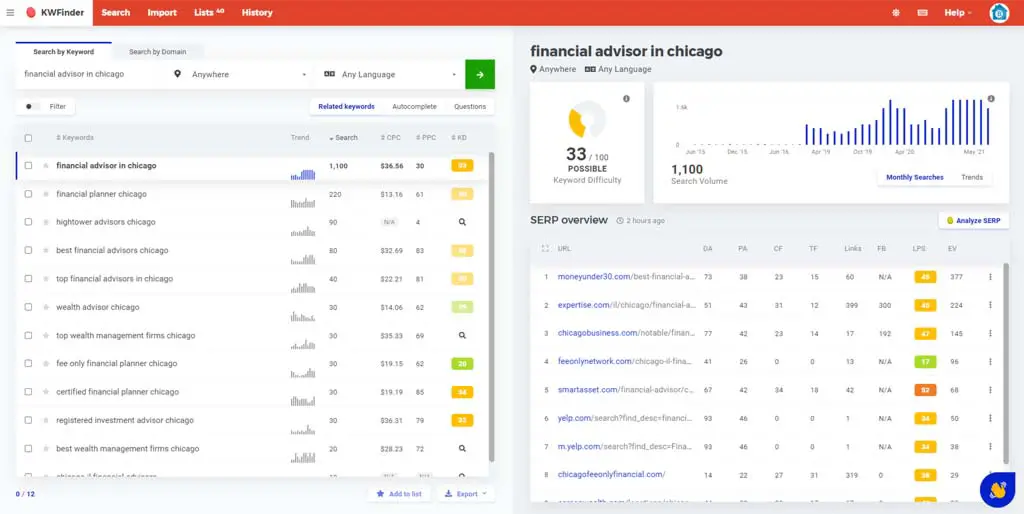
Any time you see a green-colored square under the KD (Keyword Difficulty) column, that means the keyword phrase is easy to target for SEO. As a financial advisor or planner, you should be using a tool like KWFinder to look for keywords with high search volume and low KD scores for your homepage, financial services pages, and blog posts. Following this practice will make it easier to rank high on Google for those keyword phrases to draw in potential clients.
During this stage of the process, keep adding new seed keyword variations to get additional ideas for relevant terms to target on your site. For example, try “financial advisor in Omaha” and “financial advisor in Nebraska” as well as “financial planner in Omaha” and “financial planner in Nebraska”. Exhaust all variations of your city and state and the services you offer as a wealth manager. (A table with more keyword ideas is below.)
Your goal here is to come up with a list of keyword ideas for your homepage and financial services pages.
- The homepage should target the most relevant keyword phrase for your financial planning business (e.g., financial advisor in Tulsa, Oklahoma).
- The financial services pages will target your additional service offerings, such as “retirement planning in Tulsa”, “asset allocation in Tulsa”, “estate planning in Tulsa”, etc.
Example Keyword Ideas for Financial Advisors & Planners
| Seed Keyword Idea | SEO Keyword Examples |
|---|---|
| “Financial Advisor” + [Your Local Area] | Financial Advisor in Clearwater |
| “Financial Planner” + [Your State] | Financial Planner in Ohio |
| “Financial Planning” + [Your Local Area and State] | Financial Planning in Filmont Arkansas |
| “Financial Planning Type” + [Your Local Area] | Wealth Management in Jackson |
| “Certified Financial Advisor” + [Your State] | Certified Financial Advisor in Texas |
| “Fee Only Financial Advisor” + [Your Local Area and State] | Fee Only Financial Advisor in Barton Nevada |
| “Estate Planning” + [Your Local Area] | Estate Planning in Montpelier Vermont |
| “Stock Option Advisor” + [Your State] | Stop Option Advisor in Rhode Island |
Note: These SEO keywords for financial services are just general ideas. You can mix and match the examples and use other words that apply to your particular area of expertise in financial planning.
Another thing to keep in mind here is that when creating your final list of keywords for the website, it’s best to cluster closely related keyword phrases together so you can target them all on one page. You do not want to create two or more separate pages for keywords that target close variations or the same type of client.
For example, you wouldn’t create a separate page for “financial planner in Chicago” and “financial planning in Chicago”. Both of those keywords belong on the same page because the user search intent is the same. Creating two separate pages would cause keyword cannibalization, which is a poor SEO practice that confuses Google’s algorithm about which page should rank for the relevant search queries.
However, you could write two separate pages for “wealth advisor in Chicago” and “fee only financial planner in Chicago” because those two search terms have different user intent. A person who is looking for a wealth advisor is not necessarily looking for a fee only advisor and vice versa.
Choosing Keywords for Blog Posts on Financial Topics
If you want to implement a complete SEO strategy for your financial advisor and planner services, then you’ll benefit by keeping an active blog on your site. Producing weekly or monthly blog posts on financial topics will help to attract more potential clients from Google’s search engine.
For this step, you’ll use the same keyword research method previously mentioned: looking up seed keyword ideas, finding the highest traffic terms with the lowest KD scores, and clustering similar keyword variations together on a single blog post.
The best strategy here for financial planners and advisors is to answer common questions target potential clients have about financial topics that apply to their business using seed keywords with “what”, “why”, “how”, “do”, “does”, “will”, etc. Then, write high-quality posts (explained next) that answer those questions in a helpful way while encouraging readers to reach out to your business with a well-crafted call-to-action (CTA).
Example Keyword Ideas for Financial Advising and Planning Blog Posts
| Seed Keyword Idea | SEO Keyword Examples |
|---|---|
| “What” + [Financial Advising/Planning Topic] | What is fee based financial advising |
| “Why” + [Financial Advising/Planning Topic] | Why is asset allocation important |
| “How” + [Financial Advising/Planning Topic] | How is wealth management different from asset management |
| “Do or Does” + [Financial Advising/Planning Topic] | Do financial planners do wills |
| “Will” + [Financial Advising/Planning Topic] | Will a financial advisor do a credit check |
Note: These SEO keywords for blog post topics are just general ideas. You can mix and match the examples and use other words that apply to your particular area of expertise in financial management.
6. Write High-Quality People-First Content
After you have your list of keywords figured out for the homepage, each financial services page, and blog posts (if you’re going to keep an active blog), the next part of implementing a good SEO strategy for your financial site is to put those keywords to work to get organic search traffic from Google, Yahoo, and Bing.
Now, writing high-quality content may sound obvious at first based on your financial advising experience and expertise, but in today’s SEO landscape, Google considers a certain type of content better (and more rank-worthy) than others.
This content is called “people-first content” as opposed to “search engine-first content” which is what SEO professionals are focused on. In 2022, Google implemented a Helpful Content System into its Search engine algorithms that generates a signal used by its automated ranking systems to better ensure people see original, helpful content created for people in search results.
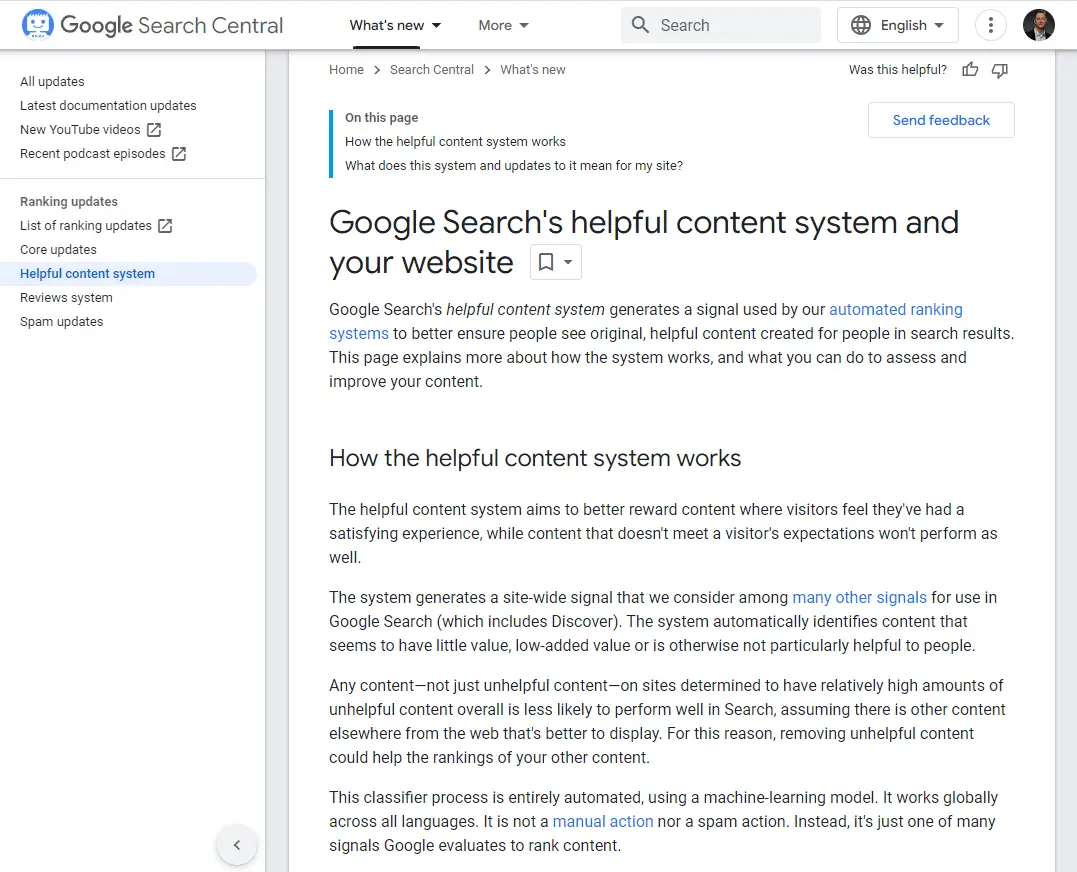
The goal of the Helpful Content System is to better reward content where visitors feel they’ve had a satisfying experience (i.e., got their needs met) instead of just ranking web pages that had the best optimization for specific keywords.
For example, as a financial advisor, you may think that a 500-word article on the value of diversifying a portfolio with index funds is great content, but Google’s Helpful Content System may not agree with you. This topic may require a much longer post with images, tables, links to backup claims, etc. Therefore, you need to know what type of content Google wants to see on the page before you start writing it.
To understand how to apply this part of the SEO strategy for your financial advising and planning site, just type one of your keyword ideas into Google’s search engine and inspect the top 5 ranking pages.
Those top-ranking pages will give you insights into the following key SEO metrics:
- The average length the article should be written.
- How the content should be structured with subheadings.
- The number of images, videos, tables, etc to include in the content, if any.
Once you conduct this type of content research for your target SEO keywords, you’ll have a better idea of how to approach the writing process so that it meets the needs of Google’s Helpful Content System, which, in turn, will also ensure your articles satisfy the user who is reading the content.
7. Optimize for On-Page SEO
Writing a high-quality piece of content is only half the battle when it comes to ranking high on Google’s search engine for relevant financial planning keywords. The other half is on-page SEO.
Without good on-page SEO, you’re content will likely not rank as high as it deserves for its target keywords. That’s because Google needs to crawl certain HTML elements on the page to correctly identify the keywords in which the content should rank in the search results.
For example, if you write a piece of content about the benefits of choosing a local financial advisor in Nashville versus a national financial planning organization, but neglect to use the target keyword phrase, “benefits of choosing a financial advisor in Nashville” in the page’s title tag, then it likely won’t rank for that search term. That’s because Google’s search engine prioritizes the text it crawls in the title tag for on-page SEO.
Now, there are about 20 HTML locations you can optimize a financial advisor website for SEO, but the 5 elements listed below are the best places for you to get started. By optimizing these locations the right way, you’ll give your content a better chance at ranking on the first page of Google without having to worry as much about the other 15 spots.
Note: If you want a comprehensive guide on on-page optimization for advanced SEO training, then check out the Complete On-Page SEO Checklist.
Meta Title Tag
The meta title tag is the top on-page SEO ranking factor for Google, Yahoo, and Bing. Get it wrong and your content will have a poor chance of ranking for the financial advising and planning keywords you’re targeting as previously mentioned.
Title tags inform Google’s search crawlers about the primary topic for the content and are what gets displayed on the search results for your listing. Therefore, the keywords you place in this HTML field are essential for higher rankings.
Using a free SEO plugin on your site like All-In-One SEO, Yoast, or RankMath makes it easy to optimize the meta title tag for a web page to include your target keywords. Once you have the plugin installed, you can write an optimized title tag for any page on your site with ease. The best way to do this is to put your main target keyword at the beginning of the page title so it appears first in Google’s search engine. This position also has the most SEO weight.
Here’s an example of a good meta title tag that’s optimized for the keyword phrase, “financial advisor in Austin”.
- Title Tag: Financial Advisor in Austin (Fee Only Wealth Management Planner)
You can also look at the top 5 ranking pages for your target SEO keyword to get ideas on how to write a well-optimized title tag. The top-ranking pages are clearly optimizing this HTML field correctly, otherwise, they would not be ranking so high in Google’s search engine.
Meta Description
The meta description is another important field you’ll want to optimize on a financial planning website across all web pages. This is also done with an SEO plugin like All-In-One SEO, Yoast, and RankMath.
Meta descriptions give Google a brief summary of what the page content is about. It’s also what appears under your listing on the search results if you optimize it correctly for relevant queries. Without implementing a good SEO strategy in this element, Google may choose to rewrite your page’s meta description by pulling other information from the content. Therefore, it’s beneficial to optimize this element correctly for on-page SEO.
A simple strategy here is to follow these SEO tips:
- Put the main target keyword as the first piece of text in the meta description.
- Include as many secondary keywords as possible without repeating too many of the same words or sounding unnatural.
- Keep the description under 160 characters because Google will truncate it to that number in the search results.
Here’s an example of a meta description that is properly optimized for the keywords “financial planning in New York”, “financial planner NYC”, and “fee only financial planner NYC”.
- Meta Description: Top financial planner in New York. As a fee only financial planner in NYC, we offer financial and investment management without earning commissions or kickbacks.
If you need additional help optimizing the meta description for a target page, follow the previous advice about doing a Google search for the main keyword phrase. The meta descriptions for the top 5 ranking pages on Google will help guide you on the word order and choices to include in this HTML element.
URL
The page URL is another important SEO ranking factor for financial service websites. Page URLs are the string of text that appears in the search bar and point to a particular page on the site. Google also displays a portion of this URL in the SERPs. Therefore, it’s good to have your main keyword as the URL.
You also want to use dashes (-), not underscores (_) between words in the URL. Google doesn’t recognize underscores as word separators and that can harm your SEO efforts on a financial advisor website.
For example, the URL for this SEO guide is:
- /seo-for-financial-advisors/
Now, if you were creating a web page for a specific financial service offering, such as “wealth management services in Tulsa, Oklahoma”, then the URL structure should look like this:
- /wealth-management-services-in-tulsa-oklahoma/
For a blog post targeting a financial planning topic, such as “why is financial planning important for small business”, the best URL would be this:
- /why-is-financial-planning-important-for-small-business/
Header Tags
The header tags for a web page include the H1 to H6 tags, which differentiate the main headings (H1) and sub-headings (H2-H6) of a page from the rest of the content.
The H1 tag is usually coded in the website’s template to be the main visible title for the page. A good rule of thumb here is to just copy the meta title tag text into the H1 tag. That way, both fields have the same primary keywords you want the page to rank for with the same structure.
For example, the meta title tag mentioned in our previous example could be copied into the H1 heading for the page so it looks like this:
- H1 Heading: Financial Advisor in Austin (Fee Only Wealth Management Planner)
The H2 to H6 tags are used to outline the content for the reader. H2s are the main subheadings, while H3s are subheadings under H2, and so forth down the line to H6.
When implementing SEO for financial advising and planning pages, you want to put your main keyword in the first H2 subheading on the page and then try to add each secondary keyword in a subsequent H2 tag, if you have any, and in a natural way.
For example, a page targeting the keyword phrases “retirement planning in Vermont” and “retirement planner in Vermont” could optimize two H2 subheadings on the page like this:
- H2 Subheading: Retirement Planning In Vermont Overview
- H2 Subheading: Choosing a Retirement Planner In Vermont
If your content has any H3 subheadings, you can put keyword variations and partial-match keyword phrases in this HTML tag to help boost the on-page SEO signals without overoptimizing the target keywords.
For example, the following text could be placed in H3 subheadings for the “Retirement Planning In Vermont Overview” H2 section to bolster on-page relevance:
- H3 Subheading: Vermont Retirement Eligibility
- H3 Subheading: Planning for Retirement Steps
- H3 Subheading: Healthcare Requirements for Retirees
As for the H4 to H6 tags, these HTML elements can be ignored for on-page SEO as they don’t have as much influence on search engine rankings. You can choose to use them, if needed to outline the content for the reader, or ignore them without any worries about the impact for SEO.
8. Improve Sitewide SEO Signals
Another step you can take to improve SEO for a financial planner and advisor website is to optimize two sitewide SEO signals: internal links and the navigation menu.
Optimizing Internal Links
Linking internally to a web page on your site can boost the topical relevance of that page for the target keyword when the anchor text for the link is optimized correctly. This SEO strategy gives Google’s crawlers additional signals that confirm what keywords the content should be indexed and ranked for in the search results.
Here’s an example of how to use this internal linking strategy for financial advisors that have a web page targeting the keyword phrase “wealth management for seniors”.
- A blog post about “wealth management options” can contain a section on senior citizens. In that section, an internal link can be placed in the content that leads users to the web page that explains wealth management for seniors.
- The anchor text for the internal link could be “Wealth Management for Seniors”.
Notice how the anchor text has the exact match keyword phrase in the link that the target page is focusing on for SEO. You’ll want to do something similar on your site. Link internally to other relevant web pages using the exact match keyword phrase or partial varations of it. This will improve the topical relevance for the keywords you want the target page to rank for in Google.
A good rule of thumb here is to not use the same anchor text over and over again but to add a few additional words to make each internal link unique.
For example, if we had three blog posts linking to that web page on senior citizen wealth management, then we could make each link anchor text a bit different to avoid over-optimization, such as:
- Blog Post #1 Anchor Text: Wealth Management for Seniors
- Blog Post #2 Anchor Text: Top Wealth Management for Seniors
- Blog Post #3 Anchor Text: Wealth Management Guide for Senior Citizens
Optimizing the Navigation Menu
The navigation menu is another key area you can optimize for SEO on a financial planning and advising website. Google has stated that if a web page is linked within the navigation menu, then it sends a clear signal to its ranking systems that it’s an important page for visitors and worth ranking in the search results. Therefore, it’s best to link to your most important pages in the main navigation menu.
To use this SEO strategy, simply place a link in the navigation menu with keyword-optimized anchor text for the seed keyword phrase. You don’t need to go overboard by adding the exact match phrase with your target location if you’re optimizing for such a query.
For example, if you were targeting the keyword phrase “financial management in Fort Worth”, then a good anchor for the navigation menu would be:
- Financial Management Services
You do not need to include “in Fort Worth” in the navigation menu anchor text. Also, if you were to have multiple pages that offered different financial advising and planning services, it would be odd to have “in Fort Worth” for every navigational link. Plus, over-optimizing the navigation menu like that could be seen as keyword stuffing by Google’s search crawler, which could result in a ranking penalty.
The best SEO advice for financial advisors and planners here is to make the navigation menu anchor natural for the user while containing the seed keyword phrase.
9. Build Quality Backlinks
In some markets, you’ll find a lot of competition for SEO and financial advisors. Meaning it can be harder to rank the target keywords you want for your business. But in other markets, good on-page SEO as we mentioned previously in this guide will be all you need to succeed in Google.
For the tougher markets, you’ll want to get some high-quality backlinks pointing to your financial services site to boost its Domain Authority. The more quality links a site has, the more trust it earns in Google’s ranking algorithm systems.
An easy way to start the link building process is to contact financial advisors, retirement planners, wealth managers, and other professionals in your industry and ask them to link to your site as a recommended resource.
You can also reach out to financial and investment websites that allow guest authors and write a piece of content for those sites that include a link back to your website in the author bio section.
Additionally, you can ask your local clients who have their own businesses to link to your financial planning website from their sites. They could add a small testimonial as an endorsement of your services along with the backlink, put your brand name and link on a local resources pages, feature your business in a blog post with a link, etc.
Another option for easy link building is to donate money to local non-profits, schools, and charities. Often, these organizations will mention the names of their donors on a donor page with a link back to the business’s homepage, which can help increase the Domain Authority and trust for Google’s ranking algorithms.
For even more techniques to build backlinks for your financial planning and advising site, see these other link building guides:
- How to Get High Quality Backlinks: 25+ Strategies
- How to Build Backlinks for Free: 50+ Methods
10. Improve User Experience
The final SEO strategy for financial advisors and planners is to work on improving the overall user experience on the site. Research by Google reveals that a page that takes 3 seconds to load has a 32% increase in bounce rate (i.e., users leaving the site without taking any action). And a 5-second load time increases that probability to 90%.
Additionally, websites that are not mobile-friendly, are hard to navigate, have intrusive interstitials, use small fonts, etc, can impact the user experience in a negative way. Google analyzes user experience signals like these for its ranking algorithm systems and if your site upsets users then it can impact your keyword rankings and traffic.
A good practice is to regularly assess the user experience on your site using the following strategies:
- Use Google’s PageSpeed Insights tool to measure the current speed of your web pages and get suggestions on how to improve them.
- Conduct usability tests with friends by asking them to find specific pieces of content to analyze ease of use.
- Make sure the site is fully responsive and mobile-friendly.
- Use font sizes that are between 18-22px for the main content on both desktop and mobile devices.
- Remove unnecessary interstitials (pop-ups).
Summary of SEO Strategies for Financial Advisors & Planners
I hope you enjoyed this stategy guide on SEO for financial advisors and planners.
As you discovered, the basic SEO strategy for wealth managers is to create a well-optimized Google Business Profile for local searches along with optimizing key HTML elements throughout the site and building quality backlinks to maximize the ranking value for each keyword on Google’s search engine. By combining high-quality content, a good user experience, proper keyword optimization techniques, and link building strategies, you can improve the chances of ranking your financial services site for the keywords that matter most for your business.

SEO Chatter is dedicated to teaching the fundamentals of search engine marketing to help marketers understand how to increase organic website traffic and improve search engine rankings.

